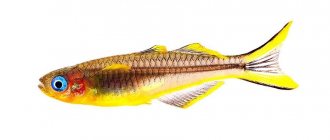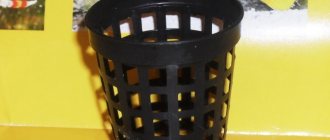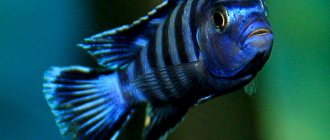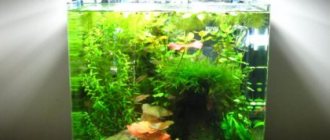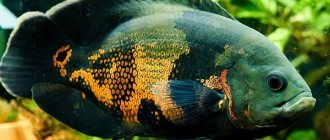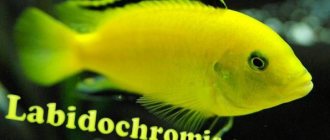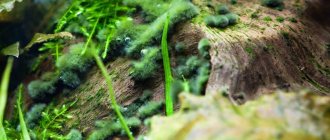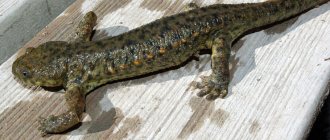This article will be useful to anyone who is selecting a fish composition for their nano-aquarium or wants to see a scattering of small, nimble fish in their spacious aquarium tanks.
Let us draw your attention to two aspects that must be taken into account when choosing a small fry.
Firstly, there are schooling fish, and there are those that hang out like herrings in an ice hole. At the same time, flocking varies. For example, blue neons are gregarious, but do not hold a wedge very clearly. And, for example, what Amanda’s tetras do is just like pie in the sky, they clearly stick to each other and maintain formation when moving. As an example of non-flocking little boobies, we can mention the micro-digestion of the galaxy, scurrying around the aquarium in all directions.
Secondly, pay attention to the degree of jumping ability. There are fish that can be kept in an open aquarium, and there are those that need a cover glass or a very lowered waterline, otherwise they will slowly eject like Japanese kamikazes over Pearl Harbor. For example, you can often find cuneiform rasboras in the form of dried roach near an aquarium. They are counterbalanced by neons and other small tetras, which are not distinguished by their jumping ability.
Next, let's move directly to the list of short aquarium babies. We will not describe the characteristics of the fish too much, we will provide links that contain everything. The main task of the topic is to provide maximum content, so that you have plenty to choose from and something to think about.
Who is too lazy to scroll with the mouse and strain the muscles of the index finger =) We invite you to watch our video about nano-fish. In it we tried to visualize all the aquarium runts!
And below, the continuation is the second part of the video story about the runts of the aquarium world.
Description
| Kingdom | Animals |
| Type | Chordata |
| Class | Ray-finned fish |
| Squad | Perciformes |
| Family | Cichlids |
| Genus | Cichlids |
They belong to the order Perciformes, suborder Perciformes, family Cichlidae.
Appearance
Black-striped cichlids are small fish that rarely grow more than 9 cm in captivity. They have a tall body, elongated in length and narrow in width. The color is blue with a purple tint, about 8 black stripes run across the body. The female has small orange spots on her abdomen.
Kinds
Cichlids are a large family of fish that includes more than ten species.
Meeka : has a more rounded and high back.
Diamond : has fewer stripes (up to 6) and a paler color.
Severum : grows up to 20 cm in length. It has an expressive red eye shell.
Managua : the largest of this family (up to 40 cm). There are no stripes. The color is spotted.
Eliot : distinguished by a bright burgundy belly. The body is yellow with orange tints.
Salvini : green to brown in color. A thick black stripe runs down the middle of the body.
Habitat in nature
The homeland of the black-striped cichlid is the waters of South America. Most often found in Panama, Chile, Brazil, and Honduras. They were later introduced to Australia, where they formed a stable population. They feel comfortable in rivers with a calm current, in lakes and ponds with a rocky bottom.
Main types of aquarium fish
In nature, there are a myriad of fish species, which are constantly replenished with hybrids and selected specimens. All representatives are divided into groups united by common characteristics.
| Family | Description | Representatives |
| Atherine | Elongated body shape with an elongated head. Color is multi-colored. The food is varied (vegetation, livestock, dry food). There are nuances in care that should be taken into account when preparing the aquarium. Peace-loving. | Red, two-color, Black Sea, Ladigesi. |
| Carp | The body is covered with scales, monochromatic. Omnivores (dry, frozen, live, canned). Unpretentious, suitable for beginners. They live in flocks. The character is flexible and gets along easily with other representatives. | Goldfish, zebrafish, labeo, barb, cardinal. |
| carp-toothed | Bright, colorful small fish (less than 10 cm). The diet consists of live food. There are no difficulties in the content. Neighbors are chosen that are large and live at other levels in the aquarium. There is an aggressive attitude. | Notobranchius: gunther, rakhova, jubbie, courthouse; Afiosemions: amieta, striatum, two-stripe, southern, filamentosum, gardner. |
| Labyrinthine (creeper-shaped) | They got their name due to their respiratory organ, which helps obtain oxygen from the atmosphere. Oblong body, compressed at the sides, small head. Multicolor representatives. The diet consists of 30% live food, the rest is omnivorous. They adapt to any living conditions, the main thing is access to oxygen. Each species has its own reaction to its neighbors. | Pineapple, cockerel, gourami, lalius, labiosa. |
| Poeciliaceae | Small fish live in schools. Wide variety of colors. The diet contains fiber. Not demanding on the maintenance of the aquarium. Suitable for beginners. There are peace-loving and aggressive representatives. | Guppies, swordtail, mollies, platies, girardinus. |
| Pomacentral | They have an oval body with flattened sides. Variegated multi-colored color. They are divided into those that feed on plants and live food. They love to feast on polyps. Whimsical fish. They are aggressive towards members of their own species and are indifferent towards others. | Amphiprion, chrysipterus, zebra dascillus, dascillus, garibaldia, clownfish. |
| Rainbows | Large schooling fish. The body is long, laterally compressed. They can be single-color (red, brown, olive) or two-color (blue and yellow). They feed on plant and animal foods. There are peculiarities in care. Peace-loving. | Melanothenia: Boesman, Parkinson's, three-stripe, neon, turquoise. |
| Catfish | Covered with skin, some representatives have a protective layer of bone plates. The sides and fins are equipped with spines for protection, and the head has whiskers for exploring the environment. The body is oddly shaped. The color is varied, mainly gray, brown, dark tones. They feed on leftover food and are herbivores. Sometimes there are predatory representatives. They are not demanding in terms of care and are considered the “orderlies” of aquariums. They are not aggressive, but can attack relatives. They are threatened by other large fish. | Agamix, pterygoplichthus, ancistrus, corydoras. |
| Characinaceae | The family has great diversity, from the smallest to the giants. There are pale and bright individuals. The diet includes everything, depending on the species. There are herbivores and carnivores. There are certain requirements when setting up an aquarium and maintaining it. Neighbors are treated differently. | Neon, erythrozonus, ternetia, ornatus, serpas, tetra. |
| Cichlids | One of the largest species of vertebrate fish. The size and shape of the body have a wide range of changes. These are mainly medium-sized fish with an oval body and pressed sides. The color is rich and bright. Omnivores (carnivores, herbivores, mixed diet). Care requires compliance with certain conditions to create a comfortable living environment. The character is peaceful, sometimes cocky. Some species can be aggressive. | Apistograms: ramiresi, Bolivian butterfly; Agassian, cockatoo; American: angelfish, discus, meeka, diamondback, black-striped; African: frontosa, lionhead, johani. |
Difficulty in content
Black-striped cichlids are very unpretentious creatures. They take root immediately in almost any aquarium. They can only be aggressive during spawning, as they begin to actively defend their territory. There is no need to maintain a special temperature balance, the main thing is that there are no chemicals in the water. Cichlids also reproduce independently and easily; they do not abandon or eat their fry.
Keeping in an aquarium
- Priming. Coarse river sand, gravel or granite chips are suitable as soil. Cichlids love to build shelters and dig at the bottom. It is advisable to equip the bottom with large stones, driftwood, and clay houses on which they can spawn.
- Plants. Vegetation must be selected with a strong root system (Cryptocoryne, Vallisneria spiralis), since these fish can tear out or dig up green spaces.
- Water parameters. It does not require a special temperature regime; water at room temperature (from 22 to 27 °C) is suitable. The hardness should vary from 2 to 20 degrees. Optimal acidity is from 7 to 8 Ph.
- Aquarium dimensions. For harmonious growth, one individual should have about 50 liters of water. The width and length of the aquarium does not matter.
- Lighting. The light in the aquarium can be anything. The power of fluorescent lamps should not exceed 0.5 watts per liter. It is worth noting that diffused sunlight will allow you to see cichlids in a new bright color.
- Aeration and filtration. This species is not whimsical. Filtration and aeration will be useful when the fry appear.
Feeding
| Feed | Price |
| Daphnia | 43 rubles for 50 g. |
| Bloodworm | 3 rubles per 1 gram. |
| Tubifex | 60 rubles for 30 ml. |
Fry need smaller food, for example, nauplii, crushed cyclops.
| Feed | Price |
| Nauplii | 655 rubles for 500 g. |
| Cyclops | 350 rubles for 500 g. |
For active growth and good health, it is necessary to combine plant and animal food. Black-striped cichlids are unpretentious eaters. Suitable animal food: tubifex, bloodworms, daphnia. In the form of vegetable food, you can give oatmeal, chopped lettuce or cabbage, and carrots.
Compatibility with other fish
Black-striped cichlids are poorly compatible with fish that are inferior or, conversely, larger in size: acaras, piranhas, guppies, mollies, goldfish. Cichlids are compatible with many fish, for example: chromis, astronotus. But for calm behavior and comfortable living, it is better to keep them in a hotel aquarium.
Diseases of the black-striped cichlid
Cichlids do not get sick more often than other aquarium species. If you follow all the rules of keeping: do not place with large species, provide quarantine for new individuals in a separate vessel, do not use chemicals to clean the aquarium, feed with healthy food, combining plant and animal. If the fish is still affected by a fungal infection, be sure to put it in a separate place and give it salt baths.
Lifespan
With proper care, this species will live for about 13 years in captivity.
average price
The price for one individual is from 300 rubles.
What kind of aquarium is called small?
Small aquariums include containers smaller than 30–40 liters; they are also called nanoaquariums. Most often they buy glass products from 5 to 20 liters. Nowadays there are aquarium kits on sale that include everything you need.
Find out how many fish should be in the aquarium.
They cost much less than large aquariums, almost any stable surface is suitable for them, and caring for such small volumes takes much less time. They like to place them simply on the desk.
Even in such a small container you can create a beautiful design using aquatic plants, driftwood, shells, stones and other elements.
Important! Due to small volumes, water indicators can change dramatically under the influence of external factors, which has a detrimental effect on its inhabitants and vegetation. Therefore, the parameters of nanoaquariums should be monitored and controlled using special equipment (filter, heater), and the water should be changed on time.
Reproduction
Cichlids become sexually mature at approximately seven months of age. During breeding, it is better to separate a couple of cichlids from other inhabitants of the aquarium, since during spawning these fish become very aggressive. Cichlids are a monogamous species; at about four months they choose a mate, with whom they continue to breed for many years. Therefore, it is better to keep no more than two pairs of cichlids in one aquarium to avoid unnecessary aggression.
Sex differences
Above - female, below - male.
The male is significantly larger than the male, has a more elongated, pointed dorsal fin and a powerful forehead. The color of the male is brighter; the female can be distinguished by orange spots on the belly.
Getting offspring
Cichlids are very caring parents. The eggs are placed in a specially dug hole with a cleaned bottom. During one spawning, the female can lay up to 600 eggs. Cichlids are extremely attentive to eggs, constantly removing eggs that have not been fertilized and protecting the nest from other inhabitants of the aquarium. After about three days, the eggs turn into larvae. And after another couple of days, full-fledged fry hatch. Parents do not abandon their children, but continue to care for and monitor them until the latter become stronger. When raising fry, the male and female work together. If one parent leaves, the second will certainly take the place of the first and will continue to monitor the brood.
Carp
These pets are among the most popular freshwater aquarium inhabitants. Most representatives are bred artificially and therefore are not found in the wild. This group is characterized by a peaceful disposition, a desire to stay in a group, and good compatibility with representatives of other species.
The most famous cyprinids are barbs, zebrafish and small freshwater sharks. You can also keep minnows, small breams, flying foxes and bitterlings in the aquarium.
Catfish Corridors
Cory catfish are one of the most beautiful tropical fish, of which there are more than 180 species. The peculiarity of this variety is the presence of six antennae, arranged in pairs. The structure of the mouth allows individuals to dig into soft soil and find food underneath it. Fish are omnivores, and they often serve as bottom cleaners, eating leftover food from it. The most unusual bottom-dwelling Cory are: red, speckled, black and white, golden, green, dwarf individuals, as well as white catfish. Due to their special body structure, fish can breathe atmospheric air. Therefore, they can float to the surface of the water at frequent intervals.
Killy fish
Killie fish belong to species that live in both freshwater and brackish waters. Killies are brightly colored. The average size of fish does not exceed 10 cm. Aquatic inhabitants feed on food and can live in the most extreme conditions.
Most often you can find on sale:
- Killy Diamond Fish;
- Gabonese Killi;
- Norman's Blue Eyes;
- Delta Killi;
- Killy the Clown;
- Lampoglazika.


